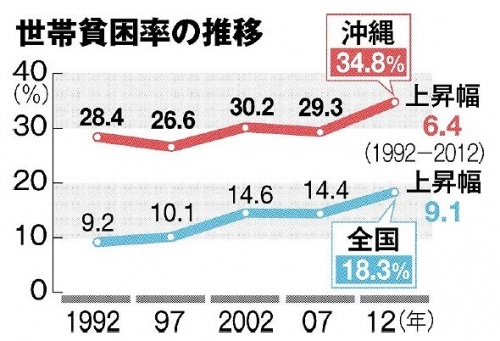Okinawa hits record high child poverty rate of 37%, 2.7 times higher than 2012 nationwide rate

Trends in Household Poverty Rates /increase rate/Okinawa/nationwide
January 5, 2016 Ryukyu Shimpo
Okinawa’s child poverty rate hit 37.5 percent in 2012, the highest in Japan. On January 4, Kensaku Tomuro, Associate Professor of Yamagata University, announced the findings of his nationwide child poverty rate survey. Results revealed that over one-third of Okinawa households with children under 18 years old are living in poverty. Okinawa’s poverty rate is about 2.7 percent times the national average of 13.8 percent. Although Osaka’s poverty rate (21.8 percent) is the second highest, Okinawa is more than ten points higher than Osaka. In addition, Tomuro calculated Japan’s overall poverty rate, including households with no children. According to his findings, Okinawa’s overall poverty rate is 34.8 percent, which is 16.5 points higher than the national average. In other words, more than one out of three households in Okinawa is living in poverty.
Based on the Comprehensive Survey of Living Conditions conducted by the Ministry of Health, Labor, and Welfare in 2012, the latest nationwide poverty rate is 16.3 percent.
Tomuro states, “The Okinawa region has held the highest poverty rate for these past two decades,” in his article scheduled for publication this February. In order to alleviate the situation, Tomuro proposes, “Welfare benefits should be completely state-funded. This will help to improve the welfare-recipient rate nationwide.” Having said that, he calls for state measures to drastically raise the minimum wage and to regulate non-regular forms of employment.
At 25.9 percent, Okinawa has the highest working-poor rate in Japan, which is 9.7 percent higher than the national average. When the survey was previously conducted in 2007, Okinawa’s poverty rate was 20.5 percent. The situation has been steadily worsening with a 5.4 percent increase since then.
In addition, the “welfare-recipient rate,” which indexes the proportion of households living on welfare benefits, is a mere 1.5 percent in Okinawa. This reflects the reality that many economically deprived families live without any support at all.
For every five years from 1992 to 2012, Tomuro has calculated the poverty rate, “welfare-recipient rate,” and “working-poor rate” by prefecture. Tomuro bases these figures on the “Basic Survey on Employment Structure”, “Survey on Public Assistance Recipients“ and “National Survey on Public Assistance Recipients” conducted by the government. “Child poverty rate” refers to the proportion of households with an income below the minimum cost of living, of those raising a child under 18 years old.
Tomuro’s article will appear in the forthcoming issue of the “Faculty of Literature and Social Sciences, Yamagata University Annual Research Report, Vol. 13” this February.
(English Translation by T&CT, Kaya Doi)
Previous Article:Beijing’s Ryukyuan burial sites under threat of development
Next Article:Fundraising for Okinawan infant with severe heart disorder reaches 350 million yen
[Similar Articles]
- Okinawa has highest poverty rate in Japan
- Okinawa’s birth rate the highest in Japan for 37 consecutive years and divorce rate is also top, but marriage rate comes second
- Okinawa to establish 3 billion yen fund to tackle child poverty
- 2016 demographics: Okinawa birthrate remains highest in Japan for 43 years straight, but natural growth rate lowest since reversion
- Editorial: 13% of children live in poverty—stop the pandemic from exacerbating inequality
 Webcam(Kokusai Street)
Webcam(Kokusai Street)


